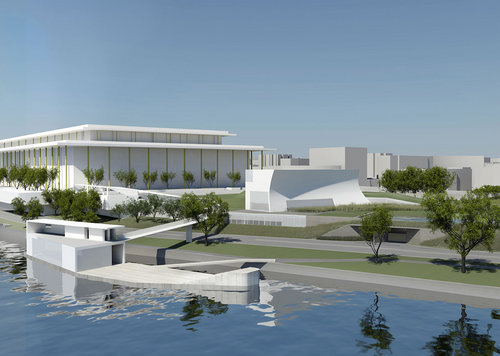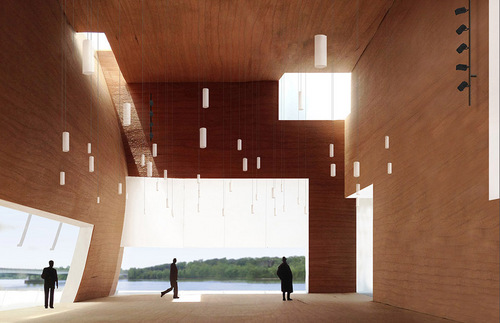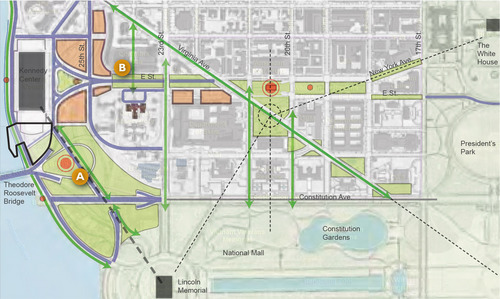The Kennedy Center is isolated from the rest of DC, but it can’t fix the problem by itself
The Kennedy Center is getting a great addition, but the design throws a spotlight on the institution’s physical isolation from the rest of the city.
The new 60,000-square foot building will include a large base tucked under an intensive green roof and three house-sized pavilions made of glass and ultra-white concrete. Two pavilions would sit on land, while the third would literally float in the Potomac.
The new design cuts the Kennedy Center off from the rest of the city
If I were to pick a word to describe the project, it’d be “islands.” To me, the project creates a string of beautiful islands near the Kennedy Center.
Unfortunately, my word choice is also an appropriate metaphor for the Center’s relationship with DC’s fabric.
In J. G. Ballard’s novel Concrete Island, an architect crashes on a London highway, stranding himself alone on a median. Penned in by speeding traffic, he can’t leave. Unable to get anyone’s attention, he watches as the city hum along without him. He ends up realizing he can’t get out and makes do with his tiny domain.
Ballard’s story is satire, but it’s not that far from what has happened at the Kennedy Center.
On one side of the building, the Rock Creek and Potomac Parkway’s flow keeps the Potomac in sight but out of reach. On the other, a vast highway trench stands between the Center, downtown, and the national memorials. A visitor could spend an evening at the Kennedy Center and come away feeling more tied to Rosslyn than the District.
A beautiful plan proves too expensive
When Congress created the Kennedy Center, federal leaders had a bold vision to disperse the city and rebuild it around a series of highways. The I-66 trench is one of the few parts of that project that ever got built, a small piece of the inner beltway.
Even before the Kennedy Center opened in 1971, writers were fighting for a less dislocated site. The New York Times architecture critic, Ada Louise Huxtable, went after the Center’s car-dependent design in a 1965 column. After its construction, proposals to make a connection other than an off-ramp came from every direction for years.
The closest DC has come to bridging the gap between the arts center and downtown came in a 2003 plan designed by Rafael Viñoly. It proposed extending E Street out to a monumental plaza on a deck, with I-66 below. Buildings on each side of the connection would have served two of the Center’s most cramped activities: arts education and rehearsal.
But decks over transportation infrastructure are hugely expensive, even for the modest buildings proposed. The plan required $400M in federal funding to reconstruct the intersection, and it would cover only a fraction of the I-66 spaghetti. After the Iraq War, the money dried up and the Kennedy Center decided to make do.
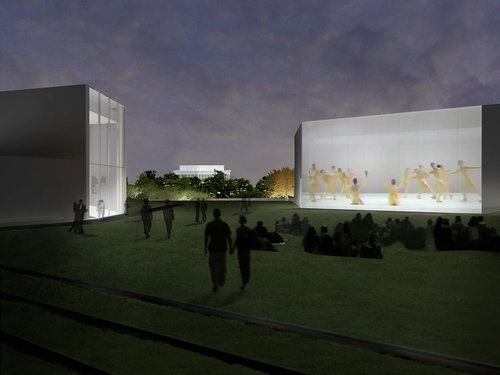
The two land pavilions frame the Lincoln Memorial, but how do you get there? Image by the Kennedy Center/Steven Holl Architects.
A more pragmatic design
In 2012, the Center asked New York architect Steven Holl to design a scheme that would at least fulfill its needs for practice facilities, multipurpose rooms, bus parking, and offices. Atop the building, a new park would pull do double-duty as an amphitheater for free simulcasts of performances inside. In general, the spaces support the more diverse cultural offerings that have become the norm for arts institutions since the 1960s.
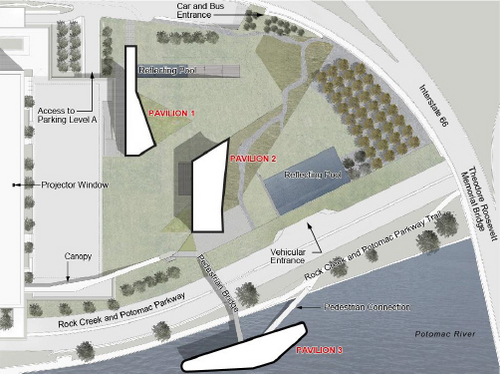
Plan of the proposed design, oriented so the top part of the map is east. Image from the Kennedy Center.
To connect the Center to the river, a bridge would cross the parkway to the floating pavilion, which would house a cafe and an informal event space. Pedestrians could walk from the Kennedy Center to the trail below, while people walking by could stop in for a show. It’s not the grand steps Viñoly’s plan imagined, but adding activity to a relatively isolated stretch of the trail might actually be better than building a big bridge that suffocates the trail below.
I think the new building’s design would quickly earn it a place among DC’s great landmarks. Holl’s architecture focuses visitors’ attention onto experiences of aspects of the physical world, particularly the ground, sky, water and light. For years, his designs have toyed with how they sit on the ground and how spending time in a particular place changes the one’s perception of it. The floating pavilion, with views subject to the tide as much as sunlight, will be a world-class extension of Holl’s history.
It’s a good project, and it’s great that it doesn’t get in the way of bigger plans.
An institution can only be as urban as its site.
At the National Capital Planning Commission’s December meeting, members criticized the addition for only making a visual connection and nothing more. “It does nothing to tell you that there’s an entire city on the other side of that gap,” DC’s acting director of planning, Ellen McCarthy, said bluntly.
Mina Wright of the US General Services Administration went further, calling the proposal an “opportunity lost to fix some ill-conceived traffic patterns, which will be fixed one day.” She brought up her agency’s ongoing redesign of the Potomac Hill complex which sits directly across I-66 from the Kennedy Center. To her, the design means giving up on a grander vision and limiting what the GSA can do with its site.

I-66 interchange dwarfs DC’s biggest buildings and cultural centers. Image from Bing with edits by the author.
But maybe it’s wrong to expect the Kennedy Center to put forth a grand vision for the site. The Viñoly plan offered yet another grand plaza, with swooping roads enabled by even more grade separation. It only solved connectivity issues that were within the Kennedy Center complex; it didn’t provide ways for the Kennedy Center to be one point in a richer fabric.
Relying on a prestige project to patch up basic infrastructure, whether it’s an arts institution or the Olympics, places a lot of trust in an organization that has narrow goals. The design process would never be as inclusive as it could be if it focused on restoring a lost neighborhood.
Repairing the fabric is already the long-term goal, set by NCPC and the Commission of Fine Arts in 2010. The problem is that their plan still assumed a massive deck over a sprawling highway even though the exorbitant costs of a smaller deck sank the last project.
The highway was the problem in 1958, it was the problem in 1971, and it’s still the problem. The solution is to replace it with surface streets.
Freeway removal is not the radical idea it was in 2003. There are multiple examples of traffic dissipating into the grid at speeds safer for everyone. That’s particularly true if transit substitutes capacity is replaced in a plan like Metro Forward, which would ease Virginia’s capacity crunch.
A city-led infill project is the most promising way to put the Kennedy Center back into Washington. There’s more potential in the site than just a grand entry. It would give DC a much richer public realm in a neighborhood trying to break out of its beige boxes. The proposed design fits well into a future that corrects the mistakes that got the Kennedy Center stuck on a freeway island.

Holl’s watercolor suggests a future bridge across the highway. Can’t we do better? Image by the Kennedy Center.

